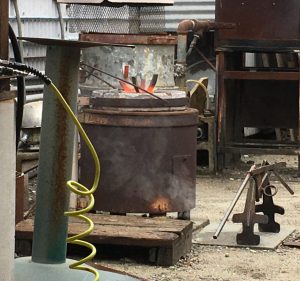The Bronze Pour
One of the joys of writing crime stories is the wild variety of research projects that come along. In Riviera Gold, that includes bronze casting. And what do you know—there’s a foundry right here in Santa Cruz.
Sean Monaghan and Courtney Scruggs of Bronze Works made me welcome, let me poke around, and invited me to a pour. They even went over my story and didn’t laugh at it (at least, not loud enough for me to hear.)

Here’s what Russell sees in Riviera Gold, with what I saw in Santa Cruz. (Rafe is the sculptor she meets at the house of Sara and Gerald Murphy, M. Ferrant is the owner of the foundry).
***
First, the masonry oven at the back was opened and the hot moulds, empty now of their wax, were transferred to the battered trough in the centre of the room.
While Rafe loaded the oven with a new set of moulds, the other two worked at the trough covering the waiting mouths with small squares of tin…
… and pouring sand from the buckets around their bases.
What followed was a dance between three men and a lot of deadly machinery. First, clamps from the device overhead, lifting the rough, white-hot crucible free of the flames. The young man skimmed the slag off the top with a long-handled iron rod with a half-circle at its end. Casual blobs of thousand-degree metal were knocked to the floor, inches from ill-protected legs, as the chain lowered the glowing stone bucket into the embrace of one of those Medieval torture instruments.
Monsieur Ferrant locked it into place. His side of this pouring contraption had two arms, allowing him to steer the crucible and control its stream.
“Hoop,” he called, and the clamped pot rose, moved, and hovered over the row of plaster mouths. “Là,” he said, and a miniature river of white-hot lava disappeared into an upraised mouth.
Moving down the row of forms, bronze filled one cup, then the next.
The angle increased with the emptying of the crucible, until again came “Hoop” and the pair emptied the crucible’s dregs into a shallow metal tray, then reversed the process with carrying frame and the tongs. The crucible disappeared back inside the furnace.
The slabs of bronze that had been pre-heating along the top were laid gently in.
Meanwhile, the forms were cooling with amazing rapidity, going from white-yellow…
to dull red to barely rose.
While the crucible sat in its nest of flames, slowly melting its new ingots, Rafe began to work the plaster shapes out of the trough and lay them to one side.
The men drank long draughts of liquid—it turned out to be small beer—and resumed their gauntlets. The oven was unloaded, the sand nestled in around these, the tallest of the pieces—but when Rafe moved to assume his handle of the pouring shanks, the older man shook his head and gestured at his assistant. The sculptor protested, but the foundry owner was adamant—and when time came to pour these, the tallest of the day’s works, I could see why. Not only were the young man’s arms nearly ten inches further off the ground than Rafe’s, but his muscles were like iron, boosting the full crucible to chest level with an ease that made my arms ache just to watch.
The pour ended, the furnace shut down, the crucible was scraped out. I was surprised to find how quickly the liquid metal set: already, Rafe was trading his leather apron and goggles for a chisel and mallet, chipping experimentally at one of the earliest moulds filled. He took care not to rest his hand on the surface, and used the chisel handle to shift the piece around. A rough shape emerged, choked with white plaster and wrapped in the octopus- sprues, but one could see the outlines of the sculpture beneath. He then propped it up to bash enthusiastically into its centre, pausing a few times to shake out hunks of broken-up core.
When he had finished, he carried his proto-sculpture in one gauntleted hand along the rope line for the admiration of all—taking care to pull it back from any out-stretching fingers. But when Rafe came to Picasso, he held the piece out as a man might display a new-born son. The Spaniard bent over it, his finger sketching a line some inches above its surface, then reached out to deliver a hearty slap on Rafe’s biceps.
***
You can read more, two weeks from today on the Riviera Gold publication day. In the meantime, you can also see more “Background Research” videos for Riviera Gold on my YouTube Channel.
Riviera Gold (here) comes out June 9, and is available signed from Bookshop Santa Cruz or Poisoned Pen—or from your local Independent bookshop, or Barnes & Noble/Nook, or Amazon/Kindle, or CD or audio.
And—the following excellent Indie bookshops will sell you a copy with a very beautiful signed bookplate in it: Book Passage, Mysterious Books, West Portal Books, Third Place Books, and Murder by the Book.











This would be on my library’s order list, but alas! I have no idea what we are getting next fiscal year for a budget.
I have some small experience with metalwork and casting from my fine art degree, and this brings back such memories!
Silly question: would the referenced Picasso be THE Picasso?
None other.